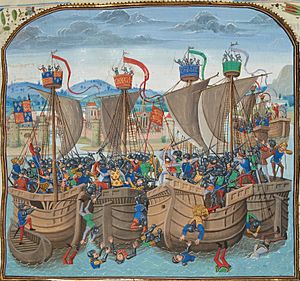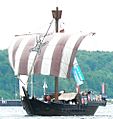Battle of Sluys facts for kids
Quick facts for kids Battle of Sluys |
|||||||
|---|---|---|---|---|---|---|---|
| Part of the Hundred Years' War | |||||||
 A miniature of the battle from Jean Froissart's Chronicles, 14th century. |
|||||||
|
|||||||
| Belligerents | |||||||
| Commanders and leaders | |||||||
| Hugues Quiéret † Nicolas Béhuchet † |
|||||||
| Strength | |||||||
| 200–250 ships | 190–213 ships | ||||||
| Casualties and losses | |||||||
| Unknown. Estimated: Several thousand. | 16,000–18,000 (La Guerre de 100 Ans by Georges Minois) to 20,000 (Europe: A History by Norman Davies) Most ships captured |
||||||
The Battle of Sluys happened on June 24, 1340. It was a very important sea battle at the start of the Hundred Years' War. The English navy attacked the French fleet near the port of Sluis. The English won a huge victory, destroying most of the French ships. This battle stopped France from being able to invade England by sea. After this, most of the fighting in the war happened on land in France.
Contents
Why the Battle of Sluys Happened
The Hundred Years' War began because the King of England, Edward III, believed he should also be the King of France. He wanted to control the French throne. To do this, he needed to invade France.
England's Plan to Invade France
King Edward III had gathered a large army in England. He planned to sail his soldiers across the English Channel to France. However, the French king, Philip VI, knew about this plan. Philip gathered a large fleet of ships to stop the English invasion.
The French fleet was made up of many ships, including some from Genoa (a powerful Italian city-state). Their goal was to block the English fleet and prevent them from landing in France. They positioned their ships near Sluys, a port in what is now the Netherlands.
The Battle Begins: English Attack
On June 24, 1340, the English fleet, led by King Edward III himself, arrived near Sluys. The French fleet was lined up in several rows, blocking the harbor.
English Tactics and Ship Design
The English ships were mostly merchant vessels, like large cargo ships called cogs. These ships were quickly turned into warships. They had tall wooden towers built on their decks. These towers gave archers a high place to shoot arrows down onto enemy ships. The English also had many skilled longbowmen.
French Fleet's Formation
The French fleet was commanded by Hugues Quiéret and Nicolas Béhuchet. They chained their ships together in three lines. This was meant to create a strong wall of ships. However, it also made it hard for their ships to move or escape.
Fighting on the Sea
The battle started with the English sailing towards the French lines. The English used their archers to fire thousands of arrows at the French ships.
Hand-to-Hand Combat at Sea
After the arrows, the English ships crashed into the French ships. Soldiers then boarded the enemy vessels. This turned the sea battle into many small, fierce hand-to-hand fights on the decks of the ships. It was like a land battle, but on water.
English Victory and French Losses
The English fought bravely and used their archers very well. The French ships, chained together, could not maneuver or help each other easily. Many French sailors and soldiers were killed. The English captured almost all of the French ships. The French commanders, Quiéret and Béhuchet, were both killed during the battle.
Aftermath and Impact
The Battle of Sluys was a huge victory for England. It had a major impact on the Hundred Years' War.
Control of the Sea
After this battle, England had control of the English Channel. This meant that English armies could cross to France whenever they wanted. It also meant that France could not launch a large-scale invasion of England.
Long-Term Effects on the War
The battle showed the importance of naval power. It also meant that the rest of the Hundred Years' War would mostly be fought on French soil. The English victory at Sluys was a strong start for King Edward III's campaign in France.
Images for kids
-
Edward III A portrait from the 18th century
-
A gold noble coin from 1354, showing Edward seated in a ship, celebrating the battle
See also
 In Spanish: Batalla de La Esclusa para niños
In Spanish: Batalla de La Esclusa para niños




